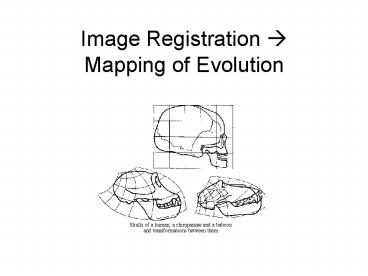Image Registration ? Mapping of Evolution - PowerPoint PPT Presentation
Title:
Image Registration ? Mapping of Evolution
Description:
Different Modality Camera Sensors primary correlation only in high resolution levels ... Apply the Laplacian high pass filter to the original images ... – PowerPoint PPT presentation
Number of Views:23
Avg rating:3.0/5.0
Title: Image Registration ? Mapping of Evolution
1
Image Registration ?Mapping of Evolution
2
Registration Goals
I2(x,y)g(I1(f(x,y))f() 2D spatial
transformationg() 1D intensity transformation
- Assume the correspondences are known
- Find such f() and g() such that the images are
best matched
3
Spatial Transformations
- Rigid
- Affine
- Projective
- Perspective
- Global Polynomial
- Spline
4
Rigid Transformation
- Rotation(R)
- Translation(t)
- Similarity(scale)
5
Affine Transformation
- Rotation
- Translation
- Scale
- Shear
No more preservation of lengths and
angles Parallel lines are preserved
6
Perspective Transformation (Planar Homography)
7
Perspective Transformation(2)
- (xo,yo,zo) ? world coordinates
- (xi,yi) ? image coordinates
- Flat plane tilted with respect to the camera
requires Projective Transformation
8
Projective Transformation
- (xp,yp) ? Plane Coordinates
- (xi,yi) ? Image Coordinates
- amn ? coefficients from the equations of the
scene and the image planes
9
Complex Transformations
Global Polynomial Transformation(splines)
10
Methods of Registration
- Correlation
- Fourier
- Point Mapping
11
Correlation Based Techniques
- Given a two images T I, 2D normalized
correlation function measures the similarity for
each translation in an image patch
Correlation must be normalized to avoid
contributions from local image intensities.
12
Correlation Theorem
- Fourier transform of the correlation of two
images is the product of the Fourier transform of
one image and the complex conjugate of the
Fourier transform of the other.
13
Fourier Transform Based Methods
- Phase-Correlation
- Cross power spectrum
- Power cepstrum
- All Fourier based methods are very efficient,
only only work in cases of rigid transformation
14
Point Mapping Registration
- Control Points
- Point Mapping with Feedback
- Global Polynomial
15
Control Points
Extrinsic Manually or Automatically selected
- Intrinsic
- Markers within
- the Image
After the control points have been determined,
cross correlation, convex hull edges and other
common methods are used to register the sets of
control points
16
Point mapping with Feedback
- Clustering example determine the optimal spatial
transformation between images by an evaluation of
all possible pairs of feature matches. - Initialize a point in cluster space for each
transformation - Use the transformation that is closest to the
best cluster - Too many points, thus use a subset
17
Global Polynomial Transformation(1)
- Use a set of patched points to generate a single
optimal transformation - Bi-Variate transformation
(x,y) reference image (u,v) working image
18
Global Polynomial Transformation(2)
- When is polynomial transformation bad?
- Splines approximate polynomial transformations(B-s
pline, TP-spline)
19
Characteristics of Registration Methods
- Feature Space
- Similarity Metrics
- Search Strategy
20
Feature Spaces
21
Similarity Metrics
22
Search Strategies
23
- Robust Multi-Sensor Image Alignment
- Irani Anandan
- Direct Method(vs. Feature Based)
24
Multi Sensor Images
EO IR
Find features
Loss of important information
Original Image (Intensity Map)
Assume global statistical correlation
Often violated
25
Multi Sensor Image Representation(1)
- Same Modality Camera Sensors ? enough correlated
structure at all resolution levels - Different Modality Camera Sensors ? primary
correlation only in high resolution levels
26
Multi Sensor Image Representation(2)
- Goal Suppress non-common information capture
the common scene details - Solution High pass energy images
27
Laplacian Energy Images
- Apply the Laplacian high pass filter to the
original images - Square the results ? NO contrast reversal
- BUT
- The Laplacian is directionally invariant
28
Directional Derivative Energy Images
- Filter with Gaussian
- Apply directional derivative filter to the
original image in 4 directions - Square the resultant images
29
Alignment Algorithm
- Do not assume global correlation, use only local
correlation information - Use Normalized Correlation as a similarity
measure - Thus, no assumptions about the original data
30
Behavior of Normalized Correlation with Energy
Images
- NC1
- Two images are linearly related
- NClt1(high)
- Two images are not linearly related, yet local
fluctuations are low - NClt1(low)0
- Incorrect displacements
31
Global Alignment with Local Correlation(1)
- a, b original images
- ai,bi directional derivatives (i1..4)
- p(p1p6)T ?affine
- (u,v) shift from one image to another
- Si(x,y)(u,v) correlation surface at a
pixel(x,y)
32
Global Alignment with Local Correlation(2)
Goal Find the parametric transformation p, which
maximizes the sum of all normalized correlation
values.? global similarity M(p)
33
Solving for M(p)
- Newtons method is used to solve for M(p)
The quadratic approximation of M around p is
obtained by combining the quadratic
approximations of each of the local correlation
surfaces S around local displacement.
34
Steps of the Algorithm
- Construct a Laplacian resolution pyramid
- Compute a local normalized-correlation surface
around a given displacement - Compute the parametric refinement
- Update p
- Start over(process terminates at the highest
resolution level of the last image)
35
Outlier Rejection
- Due to the different modalities of the
- sensors, the number of outliers may be very
- large
- Accept pixels based on concavity of the
correlation surface - Weigh the contribution of a pixel by detH(u)
36
Results
EO image
IR image
Composite before Alignment
Composite after Alignment
IR image
37
Acknowledgements
- I would like to thank Compaq for making awful
computers - Professor Belongie for reviewing the slides































